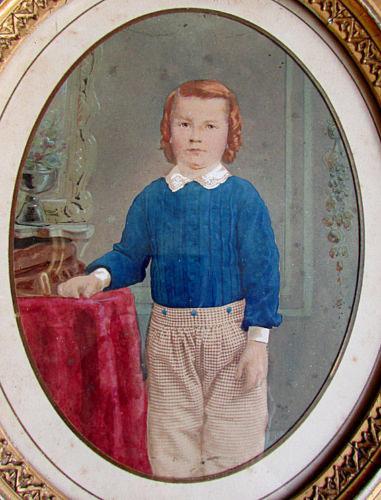
United States Boys' Clothes: Colors--Chronology

Figure 1.-- This hand-colored albumen portrait is undated, but looks to have been taken in the early-1860s, probably about 1861-63. The unidentified boys has ringlet curls and wears a bright blue blouse with brown checked pants. Not that the cillar and cuffs are a differnt material than the blouse. The white collar and wrist cuffs have a light-brown design. Th button-on pants are a light-brown check. Thus is something we do not see very commonly. Whoever worked for the studio had enormous patience. Colorizing patterns and checks is extrodinarily tedious. Of course a colorized image is not a color photograph. we tend to think that most studios made some basic attempt to replicate the colors if nit the precise hue. The studio was Fredericks Photograph & Daguerreotype Gallery at Broadway in New York City. There is a torngallery label on the back. Charles DeForest Fredricks (1823-94 ) was a well established 19th Century American Photographer who received awards for his photographic oil colors and watercolors. Of special note Fredricks photographed John Wilkes Boothe in 1862, about the time this portrait was taken.
|
|
Our information on color in American boys clothing is incomplete at this time. The popularity of some colors have notably changed over time, but some basic colors (includuing brown, blue, and grey) seem pronounced over time--at least since the 19th century. Of course, information on 19th century colors are limited by the blacks and white photography of the day. We do, however, have colorized images. and we think that for the most part that the colorized images reflect a basic representation of the actual shades worn. We note John and Charles Howell in the 1860s wearing navy-blue suits in the 1860s. We also see black and white checked blouses with what may be black pants. Military-styled peaked caps surely are navy blue and not black. As the 19th century progressed, the increasing popularity of catalogs fgives us more color information. Assessing color becomes easier in the 20th century. Color lithography and than color photography gives us more color information. Color photography was developed in the late-19th cenbtury, but was complicated and expemsive. Seceral companies were active before World War Ii, but the film and processing was expensive. Color becomes increasingly popular after World War II (1939-45), but it is not untl the 1970s and falling pries that color photograpj becomes really common. Catalogs provided detailed color information by the late-19th century, but amateur snap shots were bneeded to provide scenes showing how the clothes were being worn and in what circumstances.
The 19th Century
Our information on color in American boys clothing is incomplete at this time. The popularity of some colors have notably changed over time, but some basic colors (includuing brown, blue, and grey) seem pronounced over time--at least since the 19th century. We have some information on the early-19th century. Thete a painings. Most early american paintings are the work of nibe or untrained artists. Even so, the color reproductions are probanly very accurate. Paintings wre, however, dine in limited numbers and commissioned by the affluent which means that they cover only part of the popultion. Photography radically changed the number of available images, but for the nost prt not color imzges.
Of course, information on 19th century colors are limited by the blacks and white photography of the day. We do, however, have colorized images. and we think that for the most part that the colorized images reflect a basic representation of the actual shades worn. We note John and Charles Howell in the 1860s wearing navy-blue suits in the 1860s. We also see black and white checked blouses with what may be black pants. Military-styled peaked caps surely are navy blue and not black. As the 19th century progressed, the increasing popularity of catalogs fgives us more color information.
The 20th Century
Assessing color becomes easier in the 20th century. Color lithography and than color photography gives us more color information. Color photography was developed in the late-19th cenbtury, but was complicated and expemsive. Seceral companies were active before World War Ii, but the film and processing was expensive. Color becomes increasingly popular after World War II (1939-45), but it is not untl the 1970s and falling pries that color photograpj becomes really common. Catalogs provided detailed color information by the late-19th century, but amateur snap shots were bneeded to provide scenes showing how the clothes were being worn and in what circumstances.
HBC

Navigate the Boys' Historical Clothing Web Site:
[Return to the Main U.S. color page]
[Return to the Main U.S. page]
[Return to the Main country color page]
[Introduction]
[Activities]
[Biographies]
[Chronology]
[Clothing styles]
[Countries]
[Essays]
[Bibliographies]
[Contributions]
[FAQs]
[Glossaries]
[Images]
[Links]
[Registration]
[Tools]
[ Boys' Clothing Home]
Created: 8:10 AM 6/11/2014
Last updated: 8:10 AM 6/11/2014



